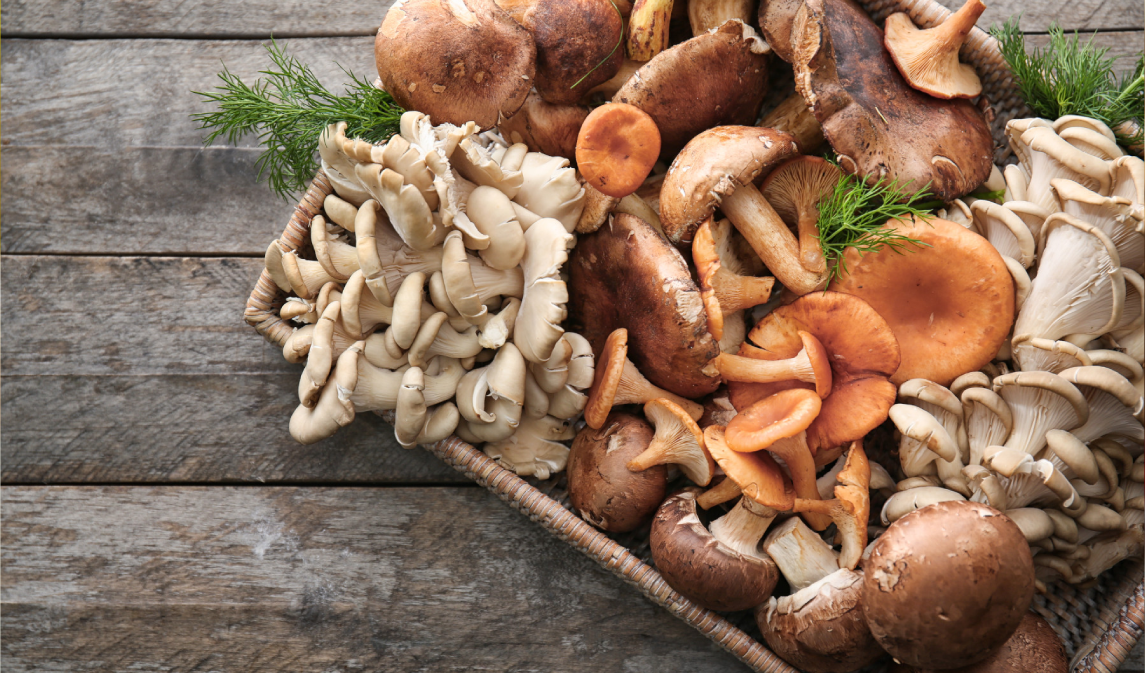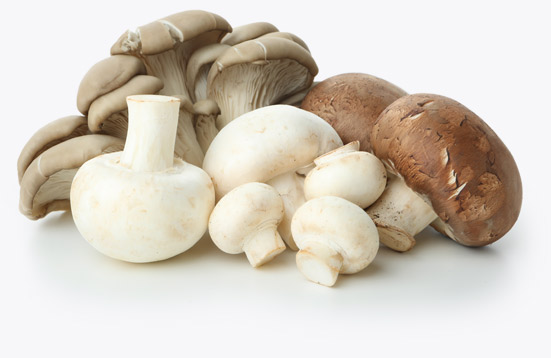Mushrooms
An often-under-appreciated food, mushrooms have been eaten and used as medicine for thousands of years. Traditional and folk medicine practitioners laud the bell-shaped fungi for their healing, cleansing and ability to improve mental health.


Mushrooms are high in polysaccharides, indoles, polyphenols,carotenoidsand B vitamins, in which cell and animal studies have shown antioxidant, anti-inflammatory, and anticancer effects.
Mushrooms are also recognized for their savory rich flavors called umami, thanks to the presence of an amino acid called glutamate.All varieties of mushrooms are low in calories and fat and, contain modest amounts of fiber and various nutrients.
Although considered a vegetable, mushrooms are neither a plant nor animal food, they are type of fungus that contains a substance called ergosterol.
Ergosterol can be transformed into vitamin D with exposure to ultraviolet light. Mushrooms vary in appearance with more than 10,000 known types, but generally they are distinguished by a stem, fleshy rounded cap, and gills underneath the cap.
Edible mushrooms produce a vast diversity of bioactive compounds such as polysaccharides, proteoglucans, terpenoids, phenolic compounds, steroids, and lectins. These compounds have a wide range of therapeutic effects and can act as immune-modulatory, anticarcinogenic, antiviral, antioxidant, and anti-inflammatory agents
Mushrooms: A Potential Natural Source of Anti-Inflammatory Compounds for Medical Applications
Source Of
- B VITAMINS (B2, B3, folate, B5)
- PHOSPHORUS
- VITAMIN D
- SELENIUM
- COPPER
- POTASSIUM
Mushrooms a Good Source of Vitamin D
A substance in mushrooms called ergosterol produces vitamin D2 (ergocalciferol), a form found onlyin plants. The other main form of vitamin D is D3 (cholecalciferol) found in animal foods (egg yolks, fatty fish) and is high in Omega 3 fatty acids. Both organic eggs and fatty, deep sea water fish will raise blood levels of vitamin D/D3.
The amount of vitamin D in mushrooms varies widely and depends on how long the mushrooms are exposed to UV light. Estimates show that fresh wild mushrooms like chanterelles and morels can contain up to 1200 IU of vitamin D per 3.5-ounce serving, whereas mushrooms grown in darkened conditions, like white button, shiitake, and oyster mushrooms, contain less than 40 IU.
Dried mushrooms also containvitamin D. Some estimates show dried mushrooms contain about 600 IU of vitamin D2 per 3.5 ounces if stored in dark, cool, dry conditions for up to 6 months. The vitamin content in mushrooms may start to break down after this time.
Humidity and cooking mushrooms in water do not appear to affect vitamin D content in mushrooms, but cooking them in fat (such as oils), can cause the vitamin to leach out because it is fat-soluble.
Medicinal Mushrooms: Bioactive Compounds, Use, and Clinical Trials


The amount of vitamin D mushrooms contain varies widely and depends on how long the mushrooms are exposed to UV light. Estimates show that fresh wild mushrooms like chanterelles and morels can contain up to 1200 IU of vitamin D per 3.5-ounce serving, whereas mushrooms grown in darkened conditions like white button, shiitake, and oyster contain less than 40 IU. 131 However, button mushrooms that are exposed to sunlight can produce up to 400 IU Vitamin D per 3.5-ounce serving though the exact amount depends on factors related to their UV exposure such as the time of day, season, latitude, and duration. Mushrooms treated with UV lamps can produce even higher amounts of vitamin D. Even after harvesting, mushrooms can continue to produce vitamin D, whether exposed to UV light from the sun or a lamp.
Dried mushrooms also contain the vitamin. Some estimates show dried mushrooms to contain about 600 IU of vitamin D2 per 3.5 ounces if stored in dark, cool, dry conditions for up to 6 months (the vitamin may start to break down after that time). [3]
Humidity and cooking mushrooms in water do not appear to affect vitamin D content in mushrooms, but cooking them in fat (such as oils) can cause the vitamin to leach out because it is fat-soluble.
Mushrooms and Health
Edible mushrooms like maitake and shiitake have also been used as medicine throughout history. Plant chemicals and components in mushrooms exert antioxidant, anti-inflammatory, and anticancer effects.
Mushrooms have been used medicinally since at least 300 B.C.E. and represent a unique branch of botanical medicines and are classifiedin the kingdom of Fungi.
Animal and cell studies show that mushrooms can stimulate the activity of immune cells, macrophages, and free radicals that can stop the growth and spread of tumor cells and cause existing tumor cells to die. Various polysaccharides in mushrooms including beta-glucans are believed to exert these cancer-fighting properties. Immune Modulation from Five Major
Mushrooms: Application to Integrative Oncology

Cognition
Epidemiological studies have found that higher mushroom intake had cognitive protective effects on the brain in older adults. Components in mushrooms may prevent the growth of amyloid proteins related to dementia, and act as antioxidants, specifically an amino acid called ergothioneine.
Mushroom intake and cognitive performance among US older adults: the National Health and Nutrition Examination Survey


Gut health
Mushrooms contain polysaccharides that act as a prebiotic, or food for beneficial gut bacteria. Studies show that these polysaccharides stimulate the growth and survival of beneficial strains like Lactobacillus and Bifidobacterium. They remain undigested and therefore can reach the colon where these bacteria live.
Mushrooms act as a prebiotics to stimulate the growth of gut microbiota, conferring health benefits to the host.
A Critical Review on Health Promoting Benefits of Edible Mushrooms through Gut Microbiota./p>
Cardiometabolic Diseases and Mushroom Consumption
Edible mushrooms have a great nutritional value including high protein, essential amino acids, fiber, vitamins (B1, B2, B12, C, and D), minerals (calcium [Ca], potassium [K], magnesium [Mg], phosphorus [P], copper [Cu], iron [Fe], manganese [Mn], and selenium [Se]).
Cardiovascular diseases are one of the most prevalent causes of morbidity and mortality in the Western world. Several investigations have shown the influence of mushrooms intake on some metabolic markers (total, LDL, HDL cholesterol, fasting triacylglycerol, homocysteine, blood pressure, homeostatic function and oxidative and inflammatory damage), which potentially may reduce the risk of suffering cardiovascular diseases.
Relevant nutritional aspects of mushrooms include a high fiber supply, a low-fat content with low trans isomers of unsaturated fatty acids and a low concentration of sodium as well as the occurrence of components such as eritadenine, phenolic compounds, sterols (such as ergosterol), chitosan, triterpenes, etc., which are considered as important responsible agents for some hitherto healthy properties.

Purchase
There are thousands of varieties of mushrooms, with different colors, shapes, and sizes. Because some wild mushrooms can cause stomach upset or allergic reactions, or may even be poisonous, your safest bet is to stick to supermarket varieties and avoid picking and eating raw wild mushrooms on your own.
The common button mushroom (Agaricusbisporus) is the most common in the U.S. It is the mildest-tasting mushroom and can be eaten raw or cooked.
Other types of mushrooms available for sale and great for human health are:
- 1. Button
- 2. Shiitake
- 3. Maitake (hen of the woods)
- 4. Cremini
- 5. Enoki
- 6. Porcini
- 7. Portobello
- 8. Morels
- 9. King oyster
- 10. Oyster
- 11. Chanterelles
- 12. Truffles
- 13. Black trumpet
- 14. Brown beech
- 15. Lion's mane
Types Of Mushrooms And How To Best Cook Them
https://www.tastingtable.com/706918/types-of-mushrooms-and-how-to-best-cook-them/
Is a truffle a mushroom?
This pricey delicacy typically reserved for restaurant dishes is a type of fungus that is generally classified as a mushroom, though there are slight differences. Truffles grow underground attached to the roots of trees, whereas mushrooms grow above ground. They don't have a stem, which is distinctive of other mushrooms, and look like a small brown lumpy potato. Truffles can have a strong flavor and aroma in contrast to the mild earthy or even neutral flavor of mushrooms. Common mushrooms grow year round, while truffles have a short growing season. Some truffles are famously expensive, at thousands of dollars per pound, such as the white truffle that grows about 3 months of the year and is difficult to find underground. Because of their rarity and top price, they may be served sparingly as fresh shavings or infused into saucesand are often paired with rich cheese and meat dishes.


Storage
Select mushrooms with firm whole caps with an even texture. They should be refrigerated until use, but ideally within one week. Do not wash or clean them until just before using. Storing in a brown paper bag with the top open will help to absorb moisture and keep them from spoiling, as opposed to tight plastic wrapping that traps moisture. Because they are about 80-90% water, mushrooms do not freeze well, becoming mushy when defrosted.
Make
Mushrooms are delicate and should be cleaned gently. Either place them under gentle running water to release any dirt or brush dirt off with a dampened paper towel.
Cooking mushrooms in high-temperature water such as boiling and microwaving may cause its water-soluble nutrients (B vitamins, potassium) to escape in the cooking water. Sautéing quickly over high heat, or simmering over low heat, such as in soups, are ideal cooking methods for preserving nutrients.
Add chopped mushrooms into salads, omelets, scrambled eggs, stir-fries, pasta sauces, chilis, or soups. Sauté mushrooms in olive oil and add to cooked pasta or whole grains. Grill large portobello mushroom caps. Remove the stems and gills if desired. Marinate the mushrooms for 10 minutes in a favorite sauce. Grill for about 3 minutes each side until they caramelize. Mushrooms make a great replacement for meat because of their umami flavor. Replace about a quarter to a half of the meat in a recipe with chopped mushrooms.


